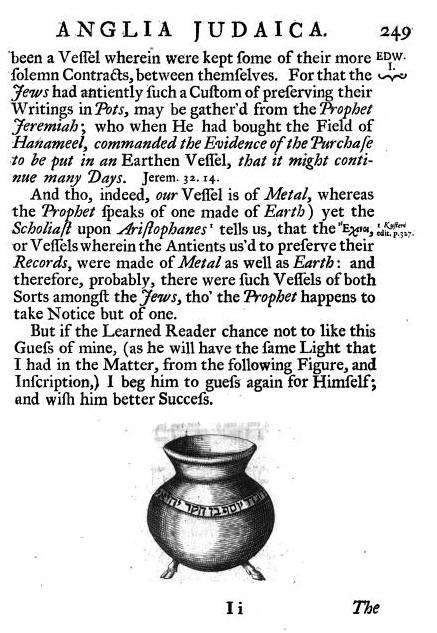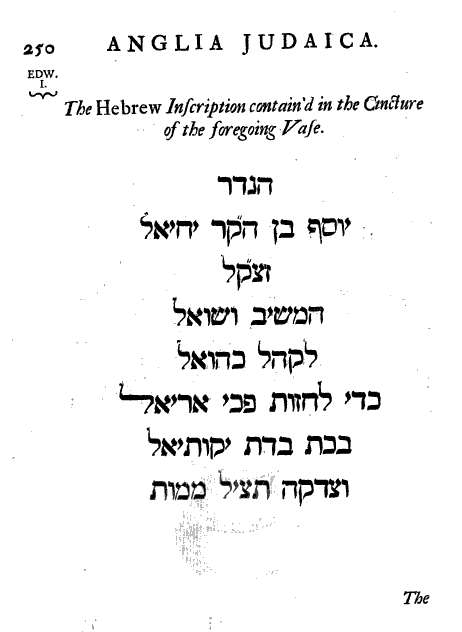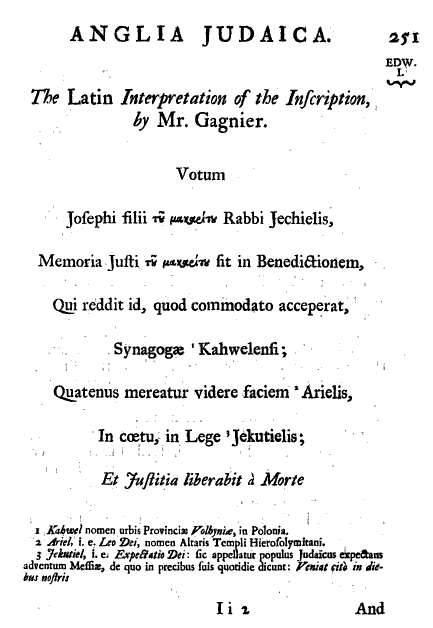In D'Blossiers Tovey's fascinating 1738 work which deals with the archaelogical remnants of English Jewry before the expulsion of 1290,
Anglia Judaica, about the "the history and antiquities of the Jews in England, collected from all our historians, both printed and manuscript, as also from the records in the Tower, and other publick repositories," he reproduces an image of a vase or an urn of sorts with a Hebrew inscription. Explaining that it was found in a brook about 40 years earlier (about 1700) , he asked Jews what it was used for, but they didn't know:




Tovey's own (way off track) guess was that it was meant to store documents. But my guess is that it was a '
tzedakah box.'
צדקה תציל ממות.
What's your interpretation?








Of course it's a pushke. What else could it possibly be?
ReplyDeleteProbably NOT Yosef's Ben Heker Yechiel's cremated remains.
ReplyDeleteLove this blog.
I propose that the fact that this is a metal vessel with an inscription mentioning zedakah as well as the fact that it rests on sculpted calve's feet with their split hooves point to the fact that it is a pot for cooking food for the poor, a variation on the tamhui of HaZaL The tamhui was a segmented pot or hot plate, but the idea of the tamhui as an implement that could provide many people many different things was later adapted in the context of daily rations provided for the poor, and public "soup kitchens."
ReplyDeleteHere are some definitions:
קופה: כספים שנאספו בצורה מאורגנת ומרכזית על-ידי הקהילה, וחולקו לעניים אחת לשבוע.
תמחוי: מנות אוכל לכלכלה יומית שנאספו במרוכז על-ידי הקהילה, וחולקו מידי יום לנזקקים.
את הכסף לצדקה (=קופה) ואת מנות האוכל לתמחוי היו גובים מתושבי המקום - בהבדל אחד: לתמחוי היו גובים מכל מי ששהה בעיר 30 יום - ובכלל זה מי ששהה במקום באופן זמני; ואילו צדקה גבו רק ממי שחי בעיר שישה חודשים לפחות - ונחשב לתושב קבע. ועוד הבדל: הצדקה ניתנה רק לתושבי העיר; ואילו חלוקת מנות אוכל (תמחוי) הייתה מיועדת לכל נזקק, גם לזה שאינו תושב המקום
See Mattia Kamm, מוסדות הצדקה בקהילה היהודית בתקופת המשנה והתלמוד from
מחויבות חברתית דרך סיפור רות המואבייה : מדריך למורה חלק א
1999
מטח : המרכז לטכנולוגיה חינוכית; קרן אבי חי
Hmm, but where is the vessel now? What are its measurements? Are there any similar objects from that time around?
ReplyDeleteMME, by Golly, that sounds right.
ReplyDeleteFunny, my initial thought was that it was a cooking vessel, perhaps for shabbat hamin. Then I read the inscription and promptly forgot that I was thinking it was for cooking.
Shimon S,
I have no idea. I'm sure it's "around." Perhaps in the British Museum. I didn't really look into it. Note that although it was found 300 years ago it probably is pre-expulsion, meaning that it's at least 700+ years old.
I am in the office and don't have access to my copy of the book, but I am sure that this is also discussed by that exotic character, Anglican vicar and apostate yeshivah bochur Rev. Moses Margoliouth (1820 - 1881) in his "Vestiges of the historic Anglo-Hebrews in East Anglia" (1870). From what I recall, his description of this object - accompanied by a drawing - indicates that it is quite large; and that its whereabouts are unknown. And I am very chuffed at providing a reference apparently unknown to our very erudite blogger!!!!
ReplyDeleteMy daughter has picked this up in her JC blog
http://thejc.com/blogpost/an-ancient-anglo-jewry-mystery
-- perhaps it wll lead to someone realising that it stands unidentified in the corner of some country house, holding a potted plant...... an aspidistra or some equally aristocratic root?
According to Wikipedia ('Earl of Oxford') the ancestral home of the now-defunct Earldom of Oxford is Castle Hedingham - http://www.hedinghamcastle.co.uk/
ReplyDeleteSomeone should take a trip out there and scout around -- how about it, Miriam and Danny!?
Hold on -- found the book.. but no time to summarise the VERY interesting discussion on pp 46 -63;59-62;81. Margouliuth disputes the translation of the inscription, and gives a very plausible series of suggestions and background. will post on this after Shabbat.
ReplyDeleteduring my visit to the british museum in Feb 2004 i noticed in a exhibit a clay cup with Aramaic/hebrew inscriptions on the inside
ReplyDeletethe exhibit location was room#52 exhibition#21 #1
i tried at the time to contact them to get a discription and followed with emails and never got a reply
so it thers anybody who is going to contact them you might as well inguire about this piece
at that time i tried this adress
ancientneareast@thebritishmuseum.ac.uk
Paul, I confess to not doing my homework. :-)
ReplyDeleteIn fact, I just wanted to make an interesting post, was pressed for time and had no inspiration.
I will follow up later. For those interested, here is Margoliouth's book:
http://books.google.com/books?id=STQRAAAAYAAJ
Since the Margoliouth txt has been posted, everyone can read it and form their own conclusions - esp regarding his theory of the purpose of the object!!
ReplyDeleteSome randon thoughts, however:
1. The legs would suggest it is not a cooking pot, which would ordinarily be suspended over a fire and have a flat base.
2. Remember that this probably would have been an item purchased and then inscribed -- ie not purpose-made, but adapted. The testimony related by Margoliouth of someone claiming to have seen a similar object might support this.
3. Several places are mentioned as possible final 'resting places' of the object. The chances are slim, but all possibilities might be worth systematically checking. If it could be found, it would be the Anglo-Jewish historical find of the century!
A presentation to R. Yechiel by the community as thanks for his service as an Askan? Much in the same way a community might present k'lei kodesh or work of art to an honoree at a banquet?
ReplyDeleteI was not proposing that it was a cooking pot, but rather a serving vessel for food previously cooked. I meant to write "a vessel for serving food cooked for the poor." Obviously the legs would obviate its use as an actual cooking vessel. Sorry for not being clear. As far as being a bought piece later inscribed, I think this is plausible, given the fact that we do have cases of aquamanile (vessels holding water for hand-washing) with later-added inscriptions. Excellent discussion!
ReplyDeleteIn the days of communal ovens, people would write their names on their chulent pots. Such stories are told of the early days of the Ashkenazi yishuv in Jerusalem, c. 1700. No idea if this was true 500 years earlier in England.
ReplyDeleteThe 'similar' bowl reported on in M's account - see p 60, seen in York, had stood "about 18" high, and weighed 76lb". Too heavy for a chulent pot! Any pot of bronze would be hugely heavy for a chulent pot. M believes it is a tzedakah box from the medieval Bury St Edmunds synagogue, especially for tzedakah for Eretz Yisrael (he surmises this from the inscription). Now, Missippi Fred will immediately respond by drawing attention to the famous controversy in the Jewish Historical Society of England regarding whether or not the building "Moyses Hall" identified in B St E (M describes it as now the local police station -- he also talks about a 'well', where he might mean a mikvah) - was or was not a synagogue. See Trans JHSE ad loc. I have neither thought nor read about this controversy for perhaps 35 yrs, but from the recesses of my memory this now bubbles up. And the inscription is surely far more than a family name inscribed on a pot so that you pulled the right one out of the baker's oven........
ReplyDeleteThe current website of Moyse (or Moyses) Hall makes no mention of its possible Jewish connection : http://tinyurl.com/39ktjrn
Among academic circles, specifically, Jewish museum curators and intellectuals of sorts, this vessel is a well known artifact. It is, without question, an alms-box. Although found in England, it is thought to have been made in Germany, specifically, Frankfurt. In 1964 an exhibition in Germany of Jewish artifacts entitled "Monumenta Judaica", there appears a nearly identical vessel to this one from England. I can e-mail photos from this exhibit showing the vessel along with a lengthy description of it in German. A similarly made bronze pot with two handles, no feet, and applied Hebrew wording resides in the Jewish Museum of New York, is dated 1579 / 1580, is from Frankfurt and is assumed to be a pot for cooking.
ReplyDeleteSpittoon from a synagogue?
ReplyDelete